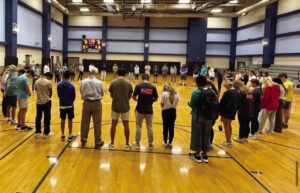Group locates graves of Revolutionary War veterans
An organization marking local gravesites of people who fought in the Revolutionary War came across a name among the war’s veterans about a year ago: John Menefee, the first judge in what became Morgan County.
But that created a separate dilemma for the the Tennessee Valley Sons of the American Revolution (SAR). The group’s members didn’t know the burial spot of Menefee — who risked his life simply by taking an oath in 1777 to the colonies battling England.
Benny Hannah of Madison, a past president of the Tennessee Valley SAR and chairman of its patriot burials, began a three-month research process to find Menefee’s gravesite, turning to the geography department at the University of Alabama at Birmingham for help.
“I secured a list of cemeteries. From that list I started going through and looking for the ones that were closest to us,” Hannah said. “Based on the information we got from the (UAB) mapping department, we went back and located it … and found the tombstone.”
Menefee is buried in an old family cemetery in a wooded area of Decatur west of Pines Park on the property of North Alabama Fabricating Co., which is no longer in operation.
The Tennessee Valley SAR hopes to restore Menefee’s broken headstone and hold a grave marking ceremony for him later this year or in 2023 as it continues an effort to locate gravesites and have ceremonies for all the Revolutionary War patriots — their term for those Americans who fought in the Revolutionary War — buried in three local counties, including Morgan County.
“To date, we believe that over 30 patriots died in Morgan County. Unfortunately, we can only find about a dozen gravesites,” Hannah said. “We believe that we can prove another 10 patriots in the Morgan County area.”
The Tennessee Valley SAR, which covers Morgan, Limestone and Madison counties, was formed in 1958 but has had a renewed interest in locating the gravesites in the last five years, Hannah said.
Hannah said the best source for finding information on patriots is documentation of their war pensions at an online data pension records site. With the Revolutionary War Pension Act of 1818 and a supplementary act in 1832, the U.S. Congress granted pensions to Revolutionary War veterans for their service.
“When we’re going through and we’re trying to prove a patriot, typically if we can find a record of where they either applied or they received a government pension, that is the best source that we can come up with that they actually participated,” Hannah said.
Jess Brown, a retired political science professor from Athens State and spokesman for the Tennessee Valley SAR chapter, said to receive a pension, the patriot had to serve a certain amount of time.
“You’re considered a Revolutionary War patriot if you served two weeks, but you wouldn’t have necessarily gotten a pension,” Brown said. “Some of them got rejected because they couldn’t produce sufficient witnesses or documentation to show service.”
—
Proof of patriotism
Brown said there is no pension record for Menefee, but the SAR discovered he was a patriot because there is documentation of the oath of allegiance he signed.
Hannah said Menefee may not have applied for a pension because he was not in need of the money. “The little pension really was nothing to him because he was already pretty well set. Maybe that was one of the reasons that he did not invest the time and effort into getting a war pension.”
A lot of other patriots that applied for pensions, Hannah said, were poor farmers and any money they could get was a big help to them.
Hannah said once the search for Menefee’s gravesite was narrowed, the SAR found that it had also been listed on findagrave.com years before.
“But no one had really done anything with it or made any plans like we’re planning on doing now to establish that recognition (of being a patriot).”
Brown said, “We’re convinced Menefee is truly a Morgan County guy with some deep roots in Morgan County because of the evidence; we have judicial records proving he was a judge.”
Menefee was born in Spotsylvania County, Virginia, on Dec. 10, 1747. His father was a well-known Methodist minister. He signed the oath of allegiance in Henry County, Virginia, on Aug. 30, 1777.
Brown said Menefee could have been tried for treason for taking an oath of allegiance.
“He stood in a public setting and signed a document that said, ‘I’m no longer loyal to the crown of England. I am loyal to this new emerging government in the United States,'” Brown said.
Menefee was a sergeant in a North Carolina regiment. He served 30 months and at the war’s end received a grant of 357 acres for his service. He deeded the land to a James Stewart in 1795.
At some point, Menefee married Frances Rhodes and they had six children.
—
Frontier Alabama
Sometime before 1817, Menefee relocated to the Alabama Territory and preached in the Methodist Church.
Cotaco County, which was renamed Morgan County in 1821 after the war hero Gen. Daniel Morgan, was founded in 1818 as a part of the Alabama Territory. On July 15, 1818, Menefee purchased 318 acres of land in Cotaco County. The land later became part of Decatur.
Menefee was appointed to be the chief justice of the first court in Cotaco County in 1818 when he was 70 years old. The court first convened June 8, 1818.
Morgan County Archivist John Allison said at that time the court system was different than it is now.
“From territorial days until 1821, local government in Alabama was accomplished by the original county court system. By an act of June 14, 1821, the old county court was broken up into two components: the orphans’ court, which would later become probate court, and the commissioners’ court. The Legislature created the commissioners’ courts to function basically as the counties’ legislative bodies,” Allison said.
Menefee died at the age of 76 on Feb. 24, 1824, after falling off a horse. He was buried on his land in what is now Decatur in a small family cemetery. There are seven other tombstones of Menefee’s family members in the cemetery with initials engraved on them, all placed around a centuries-old oak.
Allison said he believes Revolutionary War veterans moved to this area because of the newly available land. “The patterns go from Virginia and South Carolina, through Georgia a lot of times, and then they would come up here. … They’d improve the land, pull in a crop and then they’d hear, ‘OK, there’s more land opening up (elsewhere).’”
There was an Alabama settlement that relocated to Texas in the 1830s. Menefee’s wife remarried and was part of that relocation with their children.
One of Menefee’s sons, William Menefee, relocated to Texas, was also a judge, became a key founder of the Republic of Texas, signed the Declaration of Independence of Texas from Mexico, and helped select Austin as the state capital.
—
Grave markings
The Tennessee Valley SAR continues to search for the identity and gravesites of other Revolutionary War patriots buried in Morgan County.
When it comes to finding the graves of the patriots, Brown said, “You get to where you have census records that will tell you who was whose father and mother essentially, and you just keep tracking it back, another generation back and another generation back and you find out the county or community where they lived, probably at the time of their birth, and you start to look for them.”
“For a substantial number of them, we don’t know where they are buried,” Brown said. However, he said for some they know a general, probable location of their gravesite, such as a county. “For others we can specify exactly where they are.”
Hannah said after he has identified a patriot, to find a grave he usually starts with UAB’s geography and mapping department. Those departments, he said, have been locating all the cemeteries in Alabama. Hannah then looks for historical county documents.
Hannah said most Morgan County burial sites that they do know about are in old family cemeteries that are overgrown, have been neglected for years and are usually forgotten. Aside from a rare legislative grant, Hannah said, there are no funds for cleanup, so the SAR and other volunteers clean out the brush in the cemeteries. They also restore headstones, some of which are original.
Menefee’s grave became forgotten over time but in 1966 a researcher from Moulton discovered the site. The original tombstone was engraved “Sacred to the memory of John Menefee, who departed this life Feb 24, 1824, A.D. aged 76 years.”
The Daughters of the American Revolution erected a new tombstone shortly after the find. Originally, his grave was covered with a box-tomb to keep animals from digging up the grave. Currently, slabs of the box-tomb lay scattered around the tree.
Menefee’s tombstone is broken and leaning against the tree. Hannah said they will find out where the body is buried, repair the tombstone, and place it at the gravesite before the ceremony.
The most recent cemetery cleaned was the Crawford-Ryan Cemetery, in what was originally called Apple Grove, to prepare it for a ceremony earlier this year. Hannah said it took six months to clean up. SAR also repaired about 20 broken tombstones of family members of the patriot in the cemetery.
The SAR has started performing Patriot Grave Markings in which they have a ceremony and place at the grave a marble marker that has SAR patriot markings on it. The Tennessee Valley chapter performed its first two ceremonies at graves March 19.
“Once we get everything identified, we try to find any family members or descendants of the patriot itself and typically invite them,” Hannah said. To start the ceremony, the flags are posted, and the Pledge of Allegiance and the SAR pledge are said.
“We will then invite, if we have a descendant, invite them to tell anything they know about the patriot,” Hannah said. If no one is available, an SAR member will give the history of the patriot.
The honor guard wears colonial clothing, fires muskets and play taps throughout the ceremony. The two March ceremonies were for Electious (or Electius) Thompson, buried in the Russell (also known as Pines) Cemetery near Somerville, and William Evan Ryan, buried in the Crawford-Ryan Cemetery between Eva and Arab, both in Morgan County.
—
William Evan Ryan
Bob Crawford, from Morgan County, is a descendant of William Evan Ryan, who lived from March 14, 1755, to Feb. 3, 1836. Ryan was a private in the Virginia militia.
“At the conclusion of the war, in Yorktown I believe, he was still in service at that time,” Crawford said.
Ryan was born in Virginia, and Crawford said Ryan moved to Morgan County, Cotaco County at the time, around 1815 or 1820. Ryan was married to Mary Chandler and was believed to have had seven or more children. Crawford said Ryan applied for a pension while living in Morgan County.
Crawford spoke at the marking ceremony on behalf of Ryan’s descendants and said it was an impressive ceremony. “We had a really good turnout of relatives, people that were related and people that were interested.”
Tennessee Valley SAR is planning ceremonies in August, September and two more in October and November spread between Morgan County and Madison County. There will be a ceremony at Menefee’s gravesite, possibly this year, but there is a concern.
“One of our concerns is, if we end up putting the marker back there, not many people are going to see it,” Hannah said. “We’re also looking at the possibility of putting a plaque in one of the public buildings, particularly because of his notoriety with the county.”
Hannah said he does not want to rush through setting up Menefee’s ceremony “and have a lot of people miss the opportunity of seeing his importance to the county. More so just the county, especially with his descendants.”
But the Tennessee Valley SAR’s quest to honor Revolutionary War veterans now has momentum.
“Our goal for the program,” Hannah said, “will be to complete 30 grave markings prior to (America’s) 250th birthday, July 4, 2026.”















